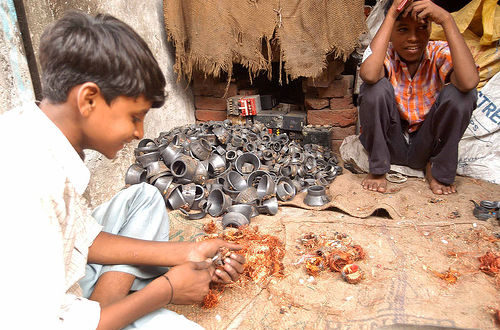Tackling E-Waste (July 5, 2011)
The production of electrical and electronic equipment is one of the fastest growing manufacturing activities worldwide. The emergent market penetration in developing countries, turnover in the developed world, and high obsolescence rates make e-waste also one of the fastest growing waste streams globally.
What’s in your e-waste?
The composition of e-waste is quite diverse and differs in products across different categories. E-waste contains more than 1000 different substances, which fall under ‘hazardous’ and ‘non-hazardous’ categories.
Roughly, it consists of ferrous and non-ferrous metals, plastics, glass, wood and plywood, concrete and ceramics, rubber, etc. Iron and steel constitute about 50% of the products, plastics – 21%, non-ferrous metals – 13%, and other constituents account for the rest. Non-ferrous metals are the likes of copper, aluminium, silver, gold, platinum, and palladium. The presence of elements such as lead, mercury, arsenic, cadmium, selenium, hexavalent chromium, and flame retardants classifies e-waste as hazardous waste.
What’s going on?
I could go on and on about the need for more robust legislation and enforcement about the trans-boundary shipments of e-waste, yet recent years have shown that very few parties are truly interested in proper regulatory framework around the management of obsolete electronics.
Despite Basel Action Network preachings, WEEE and RoHS (Restriction of Hazardous Substances in electronics) Directives, mountains of electronics from developed countries mysteriously end up in West Africa, Northern India, and Central China. “Treating” e-waste in those places certainly brings jobs to the poor — kids dipping cables in acid baths to extract the copper; pregnant women inhaling the toxic smokes from the burning of e-waste; young men heating computer boards on a steel surface to remove the computer chips soldered into it, and then those same men coughing blood; old women cutting wires — the landscape is idyllic.
I have visited some of those scrap yards and have been both threatened and shot at as I tried to take photos and shoot videos. Who is to blame for that fiasco and whom should we yell at — governments, NGOs, customs and ports? Or, instead of trying to fix the symptom, why don’t we go back to the root of the problem?

Who cares?
I work at Enviroserve, a Dubai-based company tackling the growing menace of e-waste in the Persian Gulf region, and have witnessed over and over that the industry is still lacking in efforts to take genuine responsibility for the end life of its own products. Globally, the efforts are rather scattered and half-hearted despite what many manufacturers would claim. Especially in regions where the legal framework is lax, responsible e-waste management is just a legend.
Among our clients is a myriad of original equipment manufacturers and, among those, I have noticed an incredibly different approach towards e-waste management. While some companies are outright careless, others go the extra mile and, while paying for it, comply with all international regulations — well, some do it up to a certain extent.
Since there are no e-waste refineries in the Middle East, my company is obliged to work with overseas smelters, the transportation to which significantly increases our costs. Doing the right thing does come at a price… yet, that price is transferred to the end-user upon buying the product in the first place. Yes, the money has already been raised for the responsible management of obsolete products — that same money just needs to re-enter the cycle to help take that product back to the manufacturers instead of ending up in sombre “recycling” yards in Africa and Asia.

Has anyone stepped up?
How hard is it to demand a) elimination of hazardous substances, b) taking responsibility for obsolete products, and c) redesign of electronics to last longer? To begin with, let’s have a look at Greenpeace’s Guide to Greener Electronics.
Good news — Nokia’s models since 2010 are free from a vast spectrum of toxic elements, HP should phase out the use of beryllium and compounds by the end of this month, Philips released the first ever PVC- and BFR-free TV (the Econova), and Panasonic put into place a TV take-back program in India, an industry first. These steps forward create fantastic momentum… yet, more green solutions in the electronics industry are urgently needed.
Sure, it is increasingly possible to find “greener” products on the market. However, the industry is still notoriously slow in its efforts to take responsibility for its obsolete items — try to guess why.
To me it is a no-brainer — let those smart product developers use their innovation to create products that minimize our footprint on the environment. Sound easy? The hard part is to make it happen. Who needs yet another marketing gimmick?
Photos via Greenpeace India
Source: Clean Technica

